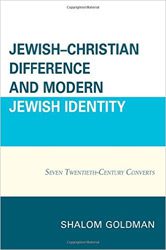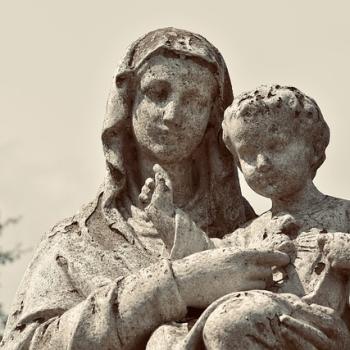
(This review is a contribution to the Patheos Book Club.)
I read Jewish-Christian Difference and Modern Jewish Identity: Seven Twentieth-Century Converts with no prior familiarity with the so-called “Jewish identity wars” that form the backdrop for its stories. Also, while I am somewhat qualified in historical scholarship, history is not my primary field and I have no competence in any historical specialty that would give me special insight here (Jewish history, Israeli history, Jews during and after WW2 or the like). The vantage point I do have is that of someone with a lot to learn from this book and from this author.
The only definite expectation I had when I opened Goldman’s book was gratified. I did indeed find it refreshing to hear stories, including conversions to and from Christianity, told without any pleading for or against a Christian standpoint. While I believe Christianity in general and Catholicism in particular, I don’t wish to hear all stories involving them told in the skewed vision brought about by looking for some kind of “winners” and “losers” – of recruits to and away from some real or imagined cause. Too often conversion stories are only told in terms of how the convert came to share or reject the storyteller’s viewpoint. Mindful of this liability, Goldman opts to give a through and through historical account, taking sides only against those who would obscure these converts’ own voices and beliefs, not for or against those who might share or critique those beliefs.
Anyone with a specific confessional standpoint on Jewish or Christian beliefs, or who has a personal opinion about what is and is not a valid Jewish identity, will be inclined to takes sides about the truth or falsehood of these convert’s beliefs. For his part, Goldman is unconcerned with offering such opinions, but focuses on the prior task of recounting those beliefs, how they changed over time, and what happened because of them. These conversion stories are told not on behalf of any set of beliefs, but on behalf of the converts themselves, as the account of their stories and beliefs together with the controversies those beliefs occasioned.
The stories here are not told in the manner of a popular biography, with an effort to make them more accessible or interesting to the reader- Jewish Christian Difference is a work of academic history. By the same token, there is nothing to alienate the non-academic reader. The style is straightforward, readable and does not rely on any appeal to prior knowledge or specialized terminology.
If the most common fault of a confessional re-telling of a conversion story is the trend towards special pleading for or against the convert’s beliefs, the corresponding historian’s error is to minimize or disregard religious motives in order to focus on solely on the convert’s secular circumstances and possible public motivations. Goldman, however, aims to restore “personal religious questions” to prominence in discussions of Jewish identity and to make them a special focus by discussing those who most often and most strongly challenge and reshape notion of Jewish identity – converts to and from Judaism. He also deftly avoids over-privileging the personal by selecting converts each of whom had a prominent public life and impact and who shaped, were shaped by or opposed the accounts of Jewish identity that were on offer in their communities.
The background, history and content of the Jewish identity controversies touched on in these lives is woven fairly seamlessly through Goldman’s text. For your convenience as a possible reader, let me condense the parts of it that stood out to me:
The most prominent historical backdrop for these stories is the Nazi extermination campaign against Jews during WW2 together with the founding of the State of Israel, intended in part to be a place of refuge for survivors of the Shoah and a protection for any Jew similarly threatened in the future. The Shoah targeted on the basis of the Nazi “racial” definition of Jewishness, which defined degree of Jewishness based on how many of someone’s grandparents were Jewish. This contrasted sharply with the traditional Rabbinic definition of Jewishness, namely, the child of a Jewish mother or a convert to Judaism. This background compounded the difficulties faced in working out a secular sense of Israeli identity properly distinct from religious identity as a Jew. Goldman notes that this effort has never been completely successful and never without controversy- especially with regard to the status of Arab and Palestinian Israeli citizens.
Further complications arise from the resistance of the Israeli rabbinate towards recognizing conversions to Judaism overseen by Reform and Conservative Jewish rabbis (a resistance not shown by Israeli law and jurisprudence). That American Reform Judaism has recognized as Jewish anyone with a Jewish father and a non-Jewish mother since 1983 raises its own set of challenges. Even more complications arise from the Israeli Law of Return which has long recognized anyone of sufficient Jewish ancestry (even those not recognized as Jewish by the rabbinate) – including those of no religion whatever- but refuses to recognize those of Jewish descent who have embraced any religion other than Judaism. Those not recognized therefore include many (especially Jewish Christians) who would have been targeted under Nazi racial policy and who are recognized as Jews by Orthodox rabbis (albeit as apostates whose role in the Jewish community would often be restricted).
Jewish Christians will usually consider themselves to be living in continuity with their Jewish roots, many will even openly advocate that in Christianity they have found the fulfillment of their Judaism. By contrast even the most secularized Jews will usually not be willing to look on a convert to Christianity as members of the Jewish community.
In these pages you will meet, among others:
Ruth Ben David, born Madeleine Feraille (1920-2000), A French Catholic who was raised in a mostly irreligious family and was deeply disenchanted with the extent of French capitulation and collaboration with the Nazi regime. Ultimately she would not only convert to Judaism, but seek out membership in one the strictest of Israeli “ultra-orthodox” communities, Meah Shearim. Aside from being one of the only women to ever have a leading role in an ultra-orthodox community, she would apply her skills at espionage (developed as part of the French resistance) in an effect to aid the community in resisting the Israeli government and Mossad.
Jean-Marie Lustiger (1926-2007), a secular Jews whose teenage reading of a Protestant Bible ultimately led him to convert to Catholicism against his parents’ express wishes. His arguments to the effect that antisemitism is as such a rejection of Christianity are given particular poignancy by the death of his mother in Auschwitz and his later service as priest, bishop and eventually Cardinal of the Roman Church. His Jewish origins and lifelong vocal declarations of Jewish identity made him both someone Rome would look to with confidence to assist on any questions of Jewish-Christian relations, and an intolerable figure to many Jews.
And Israel Zolli (1881-1956), who served as the chief rabbi of Rome during the WW2. but requested baptism as a Catholic immediately after the war. I have more than once heard it suggested that Zolli was influenced by the protection and hiding of Jews by Catholics during the war (of which he himself was a beneficiary). His conversion was then and now a source of great scandal to Zolli’s many Jewish critics, who view his apostasy from Judaism as nothing more than a backstabbing of the Jewish community at one of their most vulnerable times. Zolli himself however attributes his conversion to a series of visions of Jesus that began in 1917 and would have led him into Christianity earlier, if he had thought it right to separate himself from the Jewish community while they were facing the harsh antisemitism of the pre-war years and the Nazi occupation of Italy.
Neither these, nor the other stories told here, will do much to settle any of the myriad questions of identity that arise either within Judaism or between Jews and Christians. However, they do much to remind us all of what those questions are, why we find them important, and how we can only move toward resolving the difficulties they create by patience and by learning to see and hear those with differing beliefs for themselves– and not for their differences.













